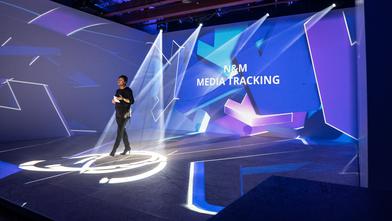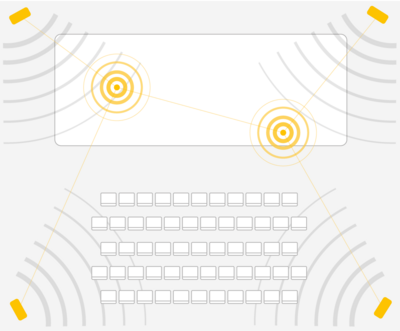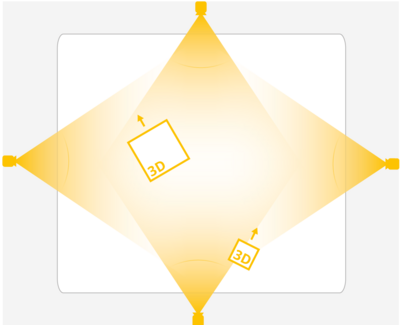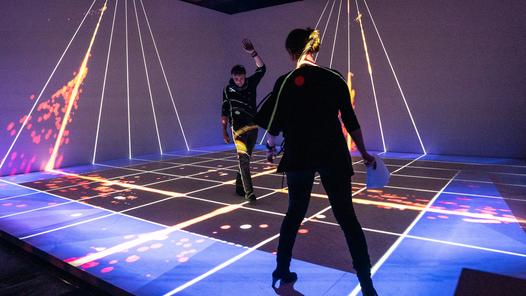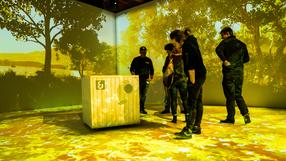Sound localisation
Localising voices and sounds, taking in moving images and reading charts: creating genuine audio reality by means of object-related sound means that all members of the audience can follow even complex content with ease. Seeing and hearing are no longer separated from one another, even at a low volume. Regardless of their distance from events on the stage, listeners perceive the sound exactly as it is produced. They always localise the source of the sound to the right place in the room, even if they or the source is moving around.
Light tracking
Automated light tracking – even with difficult stage set-ups – always presents the protagonists on stage in the right light. Automatic follow spots as well as the seamless integration of performances and content create freedom for creative processes and reduce the effort involved in rehearsals and pre-programming. Besides normal settings such as zoom, iris and focus control, there are also new and exciting opportunities for generating lighting effects that were previously hardly conceivable or difficult to realise. Defining zones also enables the automatic activation of effects and sequences – with no need for operator intervention. Using radio-based light tracking is therefore a reliable way of ensuring an agile response to the wide range of requirements demanded when staging a complex show and of implementing them in the best possible manner.
Media tracking & real-time projection mapping
Precise projections onto three-dimensional structures and buildings seem to bring the surfaces to life. Video projections onto moving objects – be it dice, a car or even a person – is considered the elite discipline in projection mapping. When realised to perfection, it can convey images, messages and emotions in a stunning way: the visual elements seem to emanate from the objects they are projected onto, or they transform whole rooms into an impressive multimedia experience.
Tracking enables localisation of objects and persons by wireless systems or cameras.
Tracking systems can be seamlessly integrated into existing, established show concepts and give lighting designers, for example, the freedom to pursue creative ideas. The operator is assisted with consistent information on positions and zones, thus benefiting from a high degree of reliability while remaining at his desk and retaining complete control of the automated part of the system. Further benefits: the cue sheet can be changed at short notice as the tracking data is always available and can be applied at any time. The error rate in the event of unplanned situations during a production can be reduced to a minimum. In light of these benefits, tracking systems represent genuine added value.
How do tracking systems work?
A wireless tracking system works with receivers (installed on a permanent or temporary basis) and transmitters (on the object to be followed). This enables objects or persons to be localised. The systems are fully scalable and currently work with an accuracy of +/- 8 cm.
This information – which incidentally is available not only in two-dimensional but also in three-dimensional form – enables stunning and very subtle effects: all spots of light, for example, can be focussed on a moving point. Or the presenter can move around freely among the audience yet it is still possible to hear where he is. When using an optical tracking system, objects such as moving cars can be localised in real-time with great precision (accuracy of 1.5 mm) with the aid of cameras and infra-red markers. This system is therefore ideally suited to projection mapping on moving objects.
Tracking software by N&M
The software especially developed by Neumann&Müller digital media enables the direct and reliable integration of various tracking systems into all areas of event production – providing an appropriate interface is available. Various sensor systems provide measurement results which are processed to form data and transmitted to a wide range of output systems. Audio, light and video can then be connected up in no time at all. A major benefit here is that the technical set-up can be changed or extended at short notice with no problem at all. One could say that the N&M software provides a multifunctional tool for tracking systems.
How the software works
Tracking systems provide information and data on an object's current position. This can be used to determine speed, radii of movement and much more. Once they have been generated in this way – and broken down accordingly – the data flows can be grouped, filtered and smoothed to extract relevant information for a large number of applications. This not only allows the analysis but also the creative development of traditional events. The software automatically removes any mismeasurements so that visualisations are always spot on, spotlights always hit the target and the current position of the presenter is always perceived by the audience.


